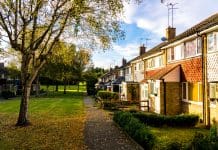74 percent of housebuilders think the government’s aim of building a million homes during the current Parliament is unachievable. Gwyn Roberts, Homes and Communities Leader at BRE Global examines what can be done to make this target a reality
Among the variety of issues that come up as barriers to achieving the government’s aim are four that occur time and time again: social housing, acceptance, skills and financing. How can raising the bar in the quality of new homes help to break down these challenges?
As part of the run-up to UK Construction Week (18th-20th October, NEC), BuildShow ran a survey of housebuilders, gaining useful insight of the market post-EU referendum. 74% of them think the government’s ambition to build a million homes in the current parliament is unachievable.
With the majority of housebuilders thinking that the EU referendum result would make achieving the target more difficult (11% thought that it would make it easier), the pressure is really on the new Prime Minister to show a clear, positive path for the UK outside of the European referendum.
Social housing
Social housing should be high up on Teresa May’s agenda, as over the last two decades social housing providers have been leaders in delivery high quality, sustainable homes that people want. These homes have transformed millions of people’s lives, often lifting them out of substandard housing. Examples such as the EcoTown in Bicester, Derwenthorpe in York or Hanham Hall in Bristol all show how social housing (combined with high-quality private sale) can have positive outcomes for all. It is time that delivering high-quality, sustainable homes should be part of the nation’s infrastructure spending.
Acceptance
According to a recent Home Builders Federation survey, 46% of people said it was unlikely that they would buy a new home. Despite efforts to try and redress this, new homes still have an image problem. This has been underlined by the recent All Party Parliamentary Group for Excellence in the Built Environment inquiry in the quality of new homes.
Our own Home Quality Mark survey found that only 4% of respondents thought that the quality of housebuilding was high, and only 10% trusted UK housebuilders highly. BRE surveys of people that live in recently built homes come out with much more positive views suggesting there is a large gap between reality and perception.
There is a different way; custom housebuilders HAB think that most of their clients are part of the 46%, those that wouldn’t normally think to buy a new home. To tackle the housing crises, more new homes must be suitable and desirable for the 46%.
Greater acceptance of new homes not only can create more sales but can also help get planning. Communities are more likely to want better quality, more sustainable homes that improve the community rather than trample on them. This could also impact the availability of land if new housing is more acceptable as landowners may well be more welcoming for development on their land.
Skills
Traditionally, the housebuilding sector hasn’t attracted enough skilled people. Some might see housebuilding at the bottom of the pile when it comes to construction work, with commercial buildings and large scale infrastructure more desirable sectors to work in. Housing is obviously important, with everyone needing a home, homes are also more than four walls and a roof; they are places where families are created and memories made. The Home Building Skills Partnership (set up by HBF and CITB) aims to support the training of 45,000 new workers with new homebuilding qualifications. Alongside this, it is the responsibility of the housebuilding sector as a whole to improve its profile, welcoming a more diverse workforce to build and sell homes with new materials, methods and ways of working. Creating better homes, which are more sustainable and of higher quality improves the profile of housebuilding.
Financing
64% of housebuilders responding to the BuildShow Questionnaire felt that SMEs were the key in achieving the target. One of the biggest (if not the biggest) barrier for SME housebuilders is financing. Finding and gaining the right financing can often be time-consuming in the planning process. For smaller developers, this becomes a disproportionate disadvantage against their larger counterparts. While the Federation of Master Builders does report that the situation is getting better, with the help from the government (such as the reported planned £5 billion fund), there is still more work to be done.
While still at the early stages, there are signs that building high quality, sustainable homes can release new streams of investment. Lloyds have recently offered £1 billion of low-interest loans for sustainable developments. BREEAM and HQM are being used as the way to measure how sustainable the development is.
Joining it all together with the Home Quality Mark
The Home Quality Mark is a new certification scheme from BRE that provides consumers with the tools to understand the benefits of their home and for housebuilders a way in which to differentiate their product.
In helping housebuilders communicate the benefits of their homes, in a trusted independent way, this can improve the image and perception of new homes, creating greater acceptance, encouraging a more diverse skilled workforce, and lever financing for both the private, the social housing sector and everything in between.
By the end of August 2016, over 4000 homes have been registered to use the Home Quality Mark, differentiating themselves from the rest of the housebuilding sector. HQM provides an overall rating of quality, then indicators for the running costs, health and wellbeing and the environmental footprint. ■
. . . . . . . . . . . . . . . . . . . . . . . . . . . . . . . . . . . . . . . . . . . . . . .
Gwyn Roberts
Homes and Communities Leader
BRE Global













